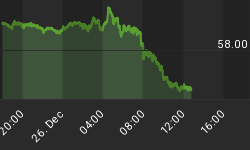Part 1 - Currency Wars: The Failing Petro$$ Strategy
with John Rubino
The Federal Reserve and its Monetary Malpractice is at the core of the American Dream becoming a myth for the vast majority of Americans. Jobs, disposable income and financial security are all under pressure, as the Federal Reserve continues its historic monetary gamble on unproven policies of Quantitative Easing and ZIRP. They are clearly failing to achieve the Feds dual manadate in the same fashion as these same policies failed Japan.Historians will show that September 2012 was a seminal month in globalization. However, it won't be because of the epic monetary foray into "Unlimited" QE and "Uncapped" OMT by central bankers. A more profound development will be the milestone agreement reached between China and Russia to begin trading oil in other than the Petro$$. This aggressive break from the status quo effectively threw down the gauntlet in recognition that the developed economies money printing was a "full throated" declaration of Currency War. These initial salvos of heavy monetary artillery clearly shook the monetary policy conference tables of the world.
This latest in eleven strategic agreements, now pits the strategy of currency debasement by the debt saturated developed economies, against the inflation fighting ramparts of the BRICS and Emerging economies. This emerging, first full scale Currency War of the 21st century, will soon challenge the long term viability of the US$ as the world's reserve currency and trading standard. With 60% of US$ now held abroad for specifically this reason, even a marginal reduction will challenge the funding capabilities of the US "welfare and warfare" state and potentially ignite hyperinflation, as US dollar IOUs are relentlessly returned for "claim".
Gordon T Long and John Rubino explore a cadre of evidence that suggests this will be a dangerous and volatile era for the global economy.
Part 2 - Triffin's Paradox & the Rule of Law
with Charles Hugh Smith
The Triffin's Paradox is a theory that when a national currency also serves as an international reserve currency, there could be conflicts of interest between short-term domestic and long-term international economic objectives. This dilemma was first identified by Belgian-American economist Robert Triffin in the 1960s, who pointed out that the country whose currency foreign nations wish to hold (the global reserve currency) must be willing to supply the world with an extra supply of its currency to fulfill world demand for this 'reserve' currency (foreign exchange reserves) and thus cause a trade deficit. The use of a national currency (i.e. the U.S. dollar) as global reserve currency leads to a tension between national monetary policy and global monetary policy. This is reflected in fundamental imbalances in the balance of payments, specifically the current account.
The US Council on Foreign Relations aptly describes why Triffin's dilemma becomes unsustainable: "To supply the world's risk-free asset, the center country must run a current account deficit and in doing so become ever more indebted to foreigners, until the risk-free asset that it issues ceases to be risk free. Precisely because the world is happy to have a dependable asset to hold as a store of value, it will buy so much of that asset that its issuer will become unsustainably burdened."
Gordon T Long and Charles Hugh Smith discuss in detail the Triffin Paradox as well as how free money from the Federal Reserve has resulted in the erosion of the Rule of Law. In fact the Federal Reserve has unwittingly become the world's largest money-laundering machine as it continues to fulfill the needs for more global US Dollars, which is central to the Triffin Paradox.
















